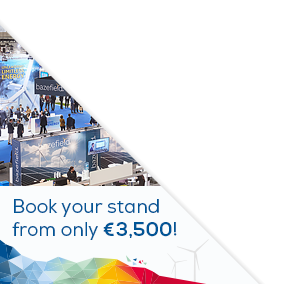Posters
Siblings:
SpeakersPostersPresenters’ dashboardProgramme committeeSee the list of poster presenters at the Technology Workshop 2025 – and check out their work!
For more details on each poster, click on the poster titles to read the abstract.

PO063: Designing floating offshore wind farm layouts with the lowest LCoE: an innovate scalable multi-objective optimization algorithm using high-performance computing (HPC)
Valerio Labattaglia, Technical Manager, Eni Plenitude SpA
Abstract
Methods. At present, conventional wind farm layout optimization solutions, including commercial software, are mainly based on energy-yield optimization rather than a more comprehensive techno-economical parameters optimization. In particular, layout optimization is a key profit lever for floating offshore wind farms, characterized by high complexity, a high number of parameters influencing wind turbines (WTGs) positioning (energy yield, mooring, anchoring, inter-array cables – IAC) and significant investments. To bridge this gap, we have developed an in-house design approach that performs coupled optimization of Annual Energy Production (AEP) and costs. The approach is based on true multi-objective algorithms and is thus able to produce an ensemble of solutions: a Pareto frontier which allows the engineers to understand the trade-offs, assess and explore alternative solutions that prioritize different objectives. The mathematical structure of the problem ensures that this approach can simultaneously produce the solution with optimal levelized cost of electricity (LCoE). Innovative contributions. The proposed optimization algorithm has WTG coordinates and IAC layout as decision variables to be optimized based on the two objectives: AEP and IAC cost. The approach can accommodate custom and non-trivial IAC cost models and implementing all required constraints for realistic usage (e.g. non-crossing, maximum number of WTGs per string, etc.). Any other objective that depends directly on WTG position can readily be incorporated. This includes, for example, moorings, anchorings or other cost items that can be modelled as position-dependent (e.g. based on depth or terrain type). Generality and flexibility to accommodate further developments are key strengths of this approach. It is one of the first examples in this emerging field to support full multi-objective optimization of energy and cost, also thanks to leveraging Eni extensive HPC resources to support computationally intensive algorithms. Our approach was also validated in a blind test against a commercial provider offering similar solutions and demonstrated comparable performance. Results and conclusions. The proposed solution was tested on a realistic business case with 46 floating offshore WTGs connected to two substations including complexities such as position-dependent wind resource definition and a custom IAC cost model that also considered different cable thicknesses along each string. The key takeaway of the analysis was that cost and energy production emerged as two conflicting objectives effectively generating a Pareto front where the extreme layouts that separately optimize the two items are significantly different. The “best LCoE” solution emerging as an intermediate trade-off. As future development we plan to deploy this tool internally to support both early-stage investment decisions and advanced engineering phases.
No recording available for this poster.







